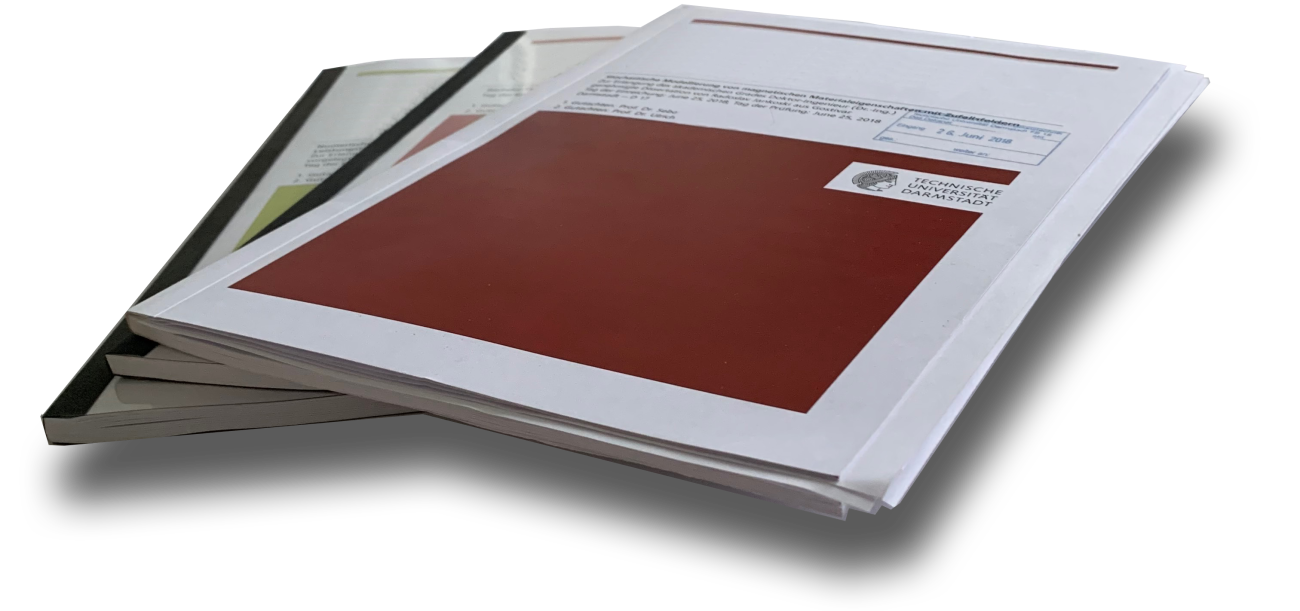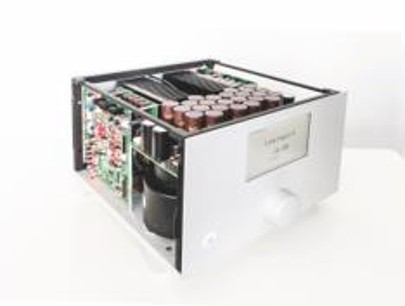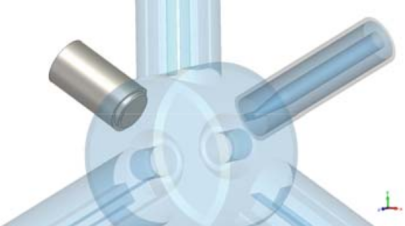EMFT - Fachgebiet Theorie Elektromagnetischer Felder

Abschlussarbeiten
Studien-, Bachelor- oder Master-Arbeiten
Im Folgenden finden Sie eine Auswahl offener studentischer Abschlussarbeiten bei uns im Fachgebiet EMFT. Weitere Arbeiten in den genannten Themenbereichen sind auf Anfrage möglich. Kontaktieren Sie uns gerne!
Der Leitfaden (wird in neuem Tab geöffnet) enthält Hinweise zum Schreiben von Abschluss- und Hausarbeiten. Außerdem stehen LaTeX-Vorlagen für Arbeiten und Vorträge bereit.
Weitere interessante Abschlussarbeiten finden Sie auch bei:
Fachgebiet Beschleunigerphysik
Bachelorarbeit, Hiwi Stelle
Hollow conductors have been widely employed in many electrical devices such as electrical machines, transformers, induction heaters and in fast ramping magnets in order to facilitate the flow of electrical current while enabling efficient thermal cooling [Mol+24]. Simulation wise, hollow conductors are very challenging to compute as they impose a multi scale problem, both geometrically and physically. The goal of this work is to develop an efficient homogenization technique for the thermal simulation of a single hollow conductor. The resulting surrogate model shall be embedded in a so-called unit-cell method, where every hollow conductor in a device is modeled as a homogenized cell, leading to an efficient numerical method for the simulation of hollow conductor coils
Betreuer/innen: Shamim Aslam, M.Sc., Dr.-Ing. Laura D‘Angelo
Masterarbeit
The Challenge: Shrinking mobility electronics demand innovative EMC solutions. This thesis develops advanced techniques to optimize EMC filters, ensuring performance and safety.
The Opportunity: Join Bosch’s EMC simulation team to contribute to the transformation of the mobility sector. You will:
• Develop Expertise: Master the application of Gaussian Processes (GPs) to optimize complex engineering problems.
• Gain Practical Experience: Apply your theoretical knowledge in a real-world industrial setting, navigating industry standards and contributing to practical solutions.
• Collaborate with Experts: Work alongside experienced EMC engineers in a motivating team environment.
Betreuer/in: Prof. Dr.-Ing. Yvonne Späck-Leigsnering
Bachelorarbeit, Masterarbeit, Projektseminar, Hiwi Stelle
The operation of bulk Nb accelerator cavities is extremely expensive due to the low-temperature helium cooling. It is expected that Nb3Sn-coated cavities and cavities with superconductor-insulator-superconductor layered coatings can be operated with higher fields and higher temperatures, leading to a decrease in power consumption. Such coatings are applied to the cavity via sputtering. However, the sputtering distribution on a complex shape, such as a TESLA cavity, is typically inhomogeneous. This leads to the question of what the influence of inhomogeneous sputtering is on the quality of the cavity. Before attempting to answer this question, we want a way to represent this sputtering distribution in a simulation software standard in the field, namely CST.
Betreuer/in: Aaron Gobeyn , M.Sc.
Bachelorarbeit, Hiwi Stelle, Projekt
The fast and accurate simulation of electric machines is crucial for prototypical design, with finite element methods being widely used. However, complex simulations can be computationally expensive. Domain decomposition (DD) methods, which split the problem into smaller sub-problems, offer a well-studied solution to accelerate these computations [2]. The approach has particular potential for designing electric machines, where the small spatial dimension of the air gap is important due to its high energy density lending itself naturally to overlapping DD methods, potentially significantly improving convergence speeds.
The project goals are to study the convergence behaviour of the overlapping domain decomposition according to different boundary conditions applied for the subdomain solves. We will implement these algorithms in the MQS FE solver Pyrit [1].
Betreuer/in: Max Schaufelberger , M.Sc.
Bachelorarbeit, Projektseminar
Computational engineering and numerical simulations are essential in designing and analyzing accelerator magnets, especially as magnet geometries become more complex. During the early design phase, engineers often need to explore multiple magnet designs quickly for rough quality estimates. However, modeling each design in a sophisticated CAD software can be time-consuming and inefficient, as many ideas will not make it past the initial phase.
This proposal aims to accelerate the process by leveraging image recognition. You will develop a Python package that can interpret hand-drawn, 2D magnet geometries– recognizing the iron yoke shape and coil wire positions – and convert them into a format compatible with our in-house Biot-Savart-based solver [1] for magnetic field simulations.
Betreuer/in: Dr.-Ing. Laura D‘Angelo
Bachelorarbeit, Masterarbeit, Projektseminar
This project focuses on the numerical characterization of sub-wavelength nanostructured photocathodes, which are a promising technology for improving photoemission quantum efficiency. By engineering the surface of the photocathode with a periodic array of nanogrooves, the structure can support a Surface-Plasmon-Polariton (SPP) mode. When coupled with an excitation laser pulse, this SPP mode enhances photon absorption, resulting in an increase in quantum efficiency (QE) and a reduction in the power requirements for the photocathode-laser system.
This research aims to contribute to the development of more efficient electron sources for future applications, particularly in the context of high-duty-cycle upgrades at facilities like the European XFEL (EuXFEL).
Betreuer/in: Margarita Bulgacheva, M.Sc.
Bachelorarbeit, Masterarbeit
High-temperature superconductors (HTS) are essential for high-field applications like particle accelerators. Their nonlinear material properties and strong dependence on temperature and magnetic fields make simulations challenging. Accurate modeling is crucial for optimizing HTS conductor designs.
This thesis aims to implement an electromagnetic simulation of HTS conductors in COMSOL Multiphysics or CST Studio Suite using the T-A or H-ϕ formulation. The focus is on analyzing magnetic field and current distribution under realistic conditions. Depending on the scope, mechanical stress from Lorentz forces may also be investigated to assess coil stability.
Betreuer/in: Lennard Langerbein , M.Sc.
Bachelorarbeit, Masterarbeit, Projekt
A multitude of devices is required to accelerate charged particles on a closed orbit of a synchrotron ring. A beam pipe separates the vacuumized particle beam trajectory from all other equipment in the tunnel and consists classically of conducting material. Bending magnets apply a strong Lorentz force on the particles which must rise proportionally to the particles’ energy. According to Lenz’ law, unwanted eddy currents are induced in the beam pipe in order to resist the change of magnetic flux density.
This work aims to quantify this disadvantageous effect of beam pipes on the field quality of bending magnets.
Betreuer/in: Dominik Moll , M.Sc.
Masterarbeit
Audionet is one of the world's leading High End sound amplifier and HiFi gear manufacturer. Even with it's over 30 years of experience the engineering team is continuously looking for the perfect sound. However, in the largely optimized electronics the perfect sound depends in no small part on the interconnect lines between the components. Both the cable configuration and its material clearly contribute to audible differences. Classical methods of electrical engineering (e.g. quadripole analysis) have so far not produced any results; corresponding measurement technology is complex or close to impracticability.
Task: The aim of the student is to find simulation methods/tools and to show the influende of different signal line configurations on the signal itself. Therefore 3-D models need to be developed, simulations of the EM fields to be carried out and the resulting waveform at the exit of the signal line to be shown (in time and frequency domain).
Prerequisites: Holistic understanding of electrical engineering contextes. Basic knowledge of field simulation, experience with programming with scripting languages. Affinity and fun for optimal sound.
This thesis is supervised by audionet GmbH in cooperation with the TU Darmstadt.
Masterarbeit
Introduction: Soon the electromotive market will rapidly grow up. One aspect for this growth is the increase of the energy density of high voltage battery systems. This systems are built up with Li-Ion cells with a module voltage up to 850V. To increase the performance of such systems, the inner resistance of the module has to be as small as possible. As a result, the short circuit current of such High Voltage Batteries reaches up to 20kA. To interrupt such a high short circuit current within 2ms the Pyrotechnical Battery Disconnector was developed by Joyson Safety Systems Aschaffenburg GmbH.
Task: Development of an electrodynamic model of a pyrotechnical battery disconnector. Transient nonlinear electrodynamic FE simulations to improve the design of the Pyrotechnical Battery Disconnector.
Betreuer/in: Prof. Dr.-Ing. Herbert De Gersem
Hiwi Stelle
Pyrit is a Finite Element Method Based numerical field simulation software written in Python to solve coupled systems of partial differential equations. Currently, the modular solver covers static and quasistatic electric and magnetic fields, stationary current problems, stationary, and transient heat conduction problems. The different modules can be coupled to analyze multiphysical engineering applications, such as e.g. foil windings, cable joints, and surge arresters. The software is under continuous development. Thus, developing further parts and maintaining existing parts of Pyrit are the main tasks.
Betreuer/in: Dr.-Ing. Jonas Bundschuh
Bachelorarbeit, Masterarbeit, Hiwi Stelle
At DESY the currently available electron gun is based on a normal conductive copper cavity operated in pulsed mode. It will be replaced by a superconducting variant to enable also CW operation. The required electromagnetic field in the cavity is then excited by a dedicated input-coupler system originating from the well-known TESLA input power coupler. Additional HOM couplers are not considered in the current design phase but may be added if required. Due to the asymmetric coupling of the resonator fields to the external sources the extracted electron beam will observe a parasitic coupler kick which has to be minimized.
Betreuer/in: Dr.-Ing. Wolfgang Ackermann
Masterarbeit
At DESY in Hamburg the particle accelerator PETRA will be equipped with new rf resonators for the acceleration of the particles. For this reason the electromagnetic properties of these cavities have to be investigated. The 3D electric and magnetic fields can be simulated with numeric tools. And these fields need to be evaluated by post processing to calculate the accelerating and deflecting effects on the charged particle beam.
Betreuer/in: Dr. phil. nat. Wolfgang F.O. Müller




